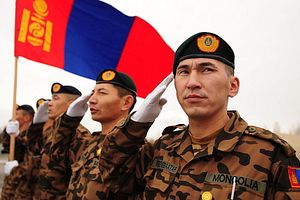Mongolia’s land-based military has faced many modernizing challenges and opportunities throughout history. The ancient Mongol army, like other great armies, whether the Greeks, Romans, or Ottomans, had its strengths and weaknesses, its historical glories and bruises. When discussing the modernization of Mongolia’s military today, a number of historical aspects remain crucial in shaping military principles, core values, and social influences. These historical aspects link to the fundamental changes, progress, and sometimes regressions of Mongolian military affairs and military diplomacy.
At its peak, the empire of the Mongols stretched from eastern Europe to eastern Siberia and the Korean Peninsula, connecting and bridging cultures, societies, and ideologies. When the Mongol army conquered new areas, it provided the empire with a modernizing opportunity: to gain access to new goods and services, exotic cultures and societies, and, most importantly, access to new military equipment, tactics, and strategies. The Mongols used traditional nomadic weaponry for centuries. The mastering of horsemanship, archery, and the introduction of steel and hooked lances were all part of the modernization of the ancient Mongol military.
Meanwhile, the Mongol conquests of Marv, Balkh, Bukhara, Samarkand, Kashgar, Turpan, Khotan, and many more capitals during the 13th century increased ethnic and cultural diversity under the Mongol empire. This historical interconnectedness paved the way for modern Mongolia to pursue political, economic, and military diplomacy with countries around the world.
In addition to Mongolia’s traditional military principles, Mongolia’s relationship with neighbor Russia became the main source of learning, technology, weapons, and strategies. From Russia, Mongolia learned both the positive and negative aspects of a top-down military structure and military institutionalization. Russia-Mongolia military ties grew strong during Mongolia’s struggle against the Qing dominance in 1911, but improved significantly during World War II. During the war, the Japanese invasion of Inner Mongolia and Manchuria allowed Stalinist Russia and Mongolia to strengthen their military ties while combating Japanese expansion in East Asia. It was the Mongolian army that supplied the Russians with horses, wool, and furs during its winter wars. Accordingly, on the 72nd anniversary of “Victory Day” on May 7, 2017, the Russian government built a large bronze war horse monument commemorating the Mongolian war horses. Mongolia’s involvement in World War II modernized its military capabilities, despite its Soviet satellite state status.
When looking at the modernization of Mongolia’s military and its social impacts, we must analyze both its foreign and domestic contributions. At home, the Mongolian military has a great responsibility to build infrastructure, schools, and hospitals. In a way, the military bridges the gap between government and civilians by constructing the necessary pieces of a modern society.
The National Center for Emergency and Disaster Relief is an important part of the military. According to the government’s official portal, through the NCEDR the military serves as first-responders for earthquakes, wildfires, and forest fires; contagious diseases; and snow and dust storms as well as severe winters (known as zud). The National Center for Emergency and Disaster Relief’s programs have produced humanitarian medics and construction engineers who build schools, hospitals, and emergency centers, especially in rural areas like Gobi-Altai, Bayan-Ulgii, and Orkhon provinces.
Despite these duties at home, Mongolia’s military is also active abroad. Mongolia’s foreign policy objectives coupled with military diplomacy have played a fundamental role in augmenting military relations with a number of countries. Mongolia’s involvement in international missions and peacekeeping operations reflect Mongolia’s historical and contemporary principles and core values. Supporting, advocating, and actively contributing to world peace is also part of the military modernization process.
According to Colonel T. Narankhuu, Mongolia’s defense and military attache to the Embassy of Mongolia in Washington D.C, “As of now, Mongolia has military diplomacy [relationship] with the U.S., Japan, Germany, and 30 other countries and has a close military-technology accord with Russia, China, Turkey, Ukraine, and Belarus.”
Since 2001, the Mongolian military has been involved in the American-led coalition’s counterterrorism efforts in Iraq and Afghanistan. According to First Lt. Mark Larson, writing from the 10th Division in Kabul, “The Mongolians, for certain, provide the most extraordinary example of international support. That Mongolia — a landlocked country of just three million people, nearly half of whom still lead a nomadic life — provides any aid at all to the international force is remarkable.” In 2006, Mongolia became the first country to host a multinational military training in the Northeast Asia region, the U.S.-supported “Command Post Exercise and Field Training Exercise with Global Peace Operations Initiative (GOI).”
Mongolia also helps protect women and children from armed militias through UN Peacekeeping Operations in the Middle East and North Africa (MENA). According to the 2016 Ranking of Military and Police Contribution to UN Operations report, Mongolia ranks 30th out of 123 countries with 950 peacekeepers operating in MENA countries.
Mongolian peacekeepers in MENA countries have been recognized by the international community; more than 850 Mongolian peacekeepers, stationed in South Sudan, were awarded the UN Medal in May 2017. Earlier, in March 2017, Srg. T.Buyanzul and O. Tsend-Ayush, from the Mongolian Battalion, saved a 2-year-old Sudanese boy from a war zone. Following this case, in July 2017, 22 armed men made an attempt to break into the refugee camps and were caught by Mongolian peacekeepers. These cases illustrate both the modernization of Mongolia’s military as a whole and its contribution to the global peace.
Bolor Lkhaajav is a Research Intern at the Ricci Institute and former security analyst with Horizon Intelligence.

































